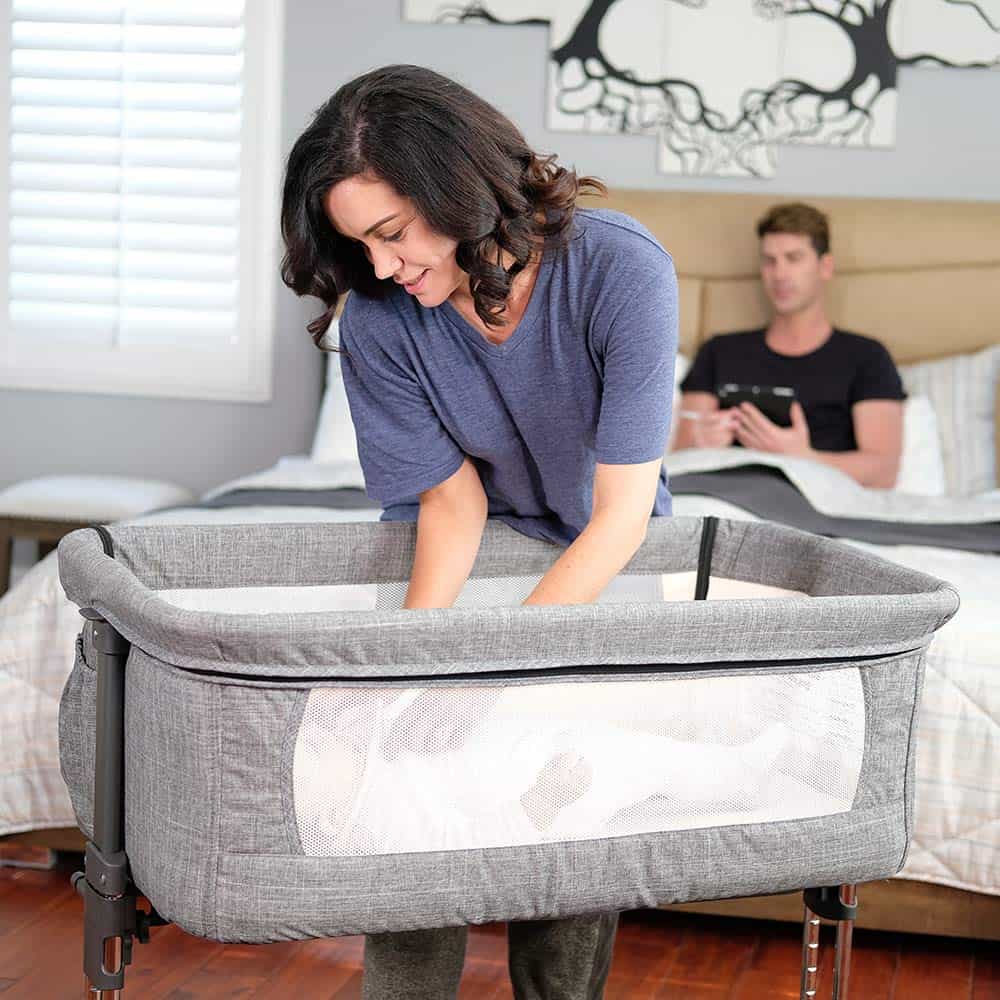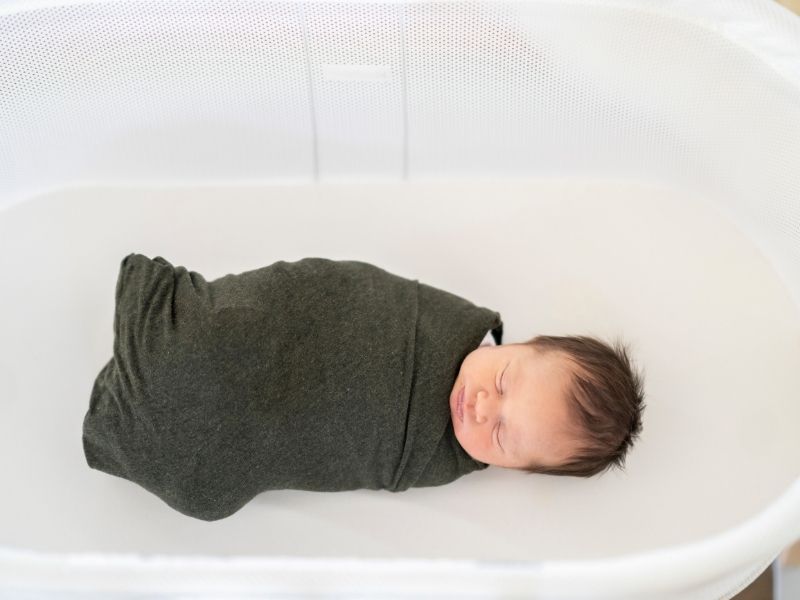If your baby won’t sleep in a bassinet, you’ve just stumbled upon THE SINGLE most complete resource of information, answers, and tactics you can use to change that.

First of all, I understand the frustration because I’ve been there.
I spent days on end trying to solve the same issue with my fussy bundle of joy.
He hated the thing.
He’d break into a crying frenzy, and we needed an hour of comfort-feeding to calm him down.
Ultimately, getting him to sleep in a bassinet was life-changing. I’m confident we can make it happen for you.
This is what we’ll cover:
- Potential reasons behind the problem
- Specific tips on how to get a baby to sleep in a bassinet
- Safety considerations – the DOs and DON’Ts of getting a newborn to sleep in a bassinet.
Let’s get to it.
1 – Potential reasons behind the problem
Why won’t my newborn sleep in their bassinet?
There’s a number of potential reasons why a newborn might be refusing to sleep in a bassinet:
- They don’t like the confine of the bassinet
- They’re hungry or gassy.
- Their startle reflex is waking them up.
- They’re cold or hot.
- Their sleep routine might be subpar, and they’re not sure if it’s night or day.
- Their diaper is dirty.
What I want to avoid here is commonplace advice.
You probably know what I’m talking about – like the last one on the list above. Of course, you’re going to check for a dirty diaper.
Here’s my point – chances are, there’s more than one reason, and trying to find one answer is a waste of everyone’s time.
That’s why we won’t dwell on the reasons.
Having said that, there’s one potential cause that deserves an explanation. It’s the first on the list, and it sounds deceptively simple.
It’s anything but.
What I mean by “they don’t like it”
Getting out of the womb and into the world is the single biggest environment change a human goes through.
It’s like moving from Florida to Russia (if Russians were trying to force feed you formula).
Some babies will have an easier time adjusting, and others (like yours and mine) will need ‘convincing.’
Bottom line – don’t obsess over the reasons why your baby doesn’t like the bassinet.
What to do instead
Make a comprehensive plan and get to work.
Cover all your bases and potential reasons – this holistic approach is what helped me. In the section below, I’ll go through it all step-by-step.
Related reads: bassinet vs. cradle vs. crib – main differences | difference between a co-sleepers and bassinets | putting a baby to sleep in a pack-and-play | Can a baby sleep in a swing?
How to get a newborn baby to sleep in a bassinet – 11 Tips
Bear with me here because some of these are common sense, but they MUST be a part of a solid plan.
1 – Check the temperature
By temperature, I mean both the baby’s and the room’s temperature. Being too hot or too cold is one of the most common reasons behind fussy nights.
You probably have this down, but let’s revisit it – the room should be comfortably cool, in the 68-72 °F range (20° to 22.2°C).
That’s the easy part because you have direct control over it. You turn a dial, and you’re a good parent.
In reality, you only get the complete picture when you consider the baby’s body temperature.
How to do it
Instead of guessing what’s good for them, reverse-engineer what’s working. If there are moments when your baby does fall asleep in the bassinet, take his temperature with a non-contact thermometer.

You might find that every time they fall asleep in the bassinet, they’re a peg warmer/colder than when they’re fussing.
You might even notice a rule about the PJ or onesie that works better.
Related reads: how long to use a bassinet
2 – Use the power of routine
You’ve heard this one before.
There’s a good reason for that. It’s because it works.
If a nice meal and warm bath get them to sleep in your arms, it’s a question of time before you build the same habit for a bassinet.
Just make sure it’s the same time every night.
Note: “Routine” also means avoiding drastic changes in daily activity levels because an overtired baby is a recipe for a restless night.
3 – Use the power of smell
This tip might sound awkward, but it’s one of the more effective ones on the list because it goes to the root of the problem.
There’s a good chance that your baby is not comfortable in the bassinet simply because they feel the mother’s absence.
Get “into the bassinet” with your baby by making the space smell like you (“you” being the mother).
To do that, sleep with the sheets for a few nights and use them in the bassinet.
I’ve read wild success stories with this one.
4 – Rethink your lights
Babies like it extra dark. In the daytime, you might want to try blackout curtains.
At night, go with a muted night light instead of the overheads.
I know, a basic piece of advice that might sound like it’s commonplace. Yet, I read success stories from parents who got their baby to sleep in the bassinet by going darker.
5 – Experiment with white noise
Again, I’m guessing that you already own a white noise machine if you have a restless rascal on your hands, but that’s not all you can do.
Take the time to research the different white noise machines out there, read the reviews and search for sleep patterns similar to your baby’s.
The logic here is this – if the problem is similar, there’s a chance the same thing might help.
6 – Make sure it’s not reflux or gas causing the problem
For babies with reflux and gas, burping might not be enough to get them comfortable. Try keeping them upright for 15-25 minutes and see if it helps at all.
To be clear, I’m talking about keeping the baby upright in your hands while they’re awake. Sleep positioners and wedges pose a serious safety hazard.
7 – Get your timing right
The one thing I’ve seen help with getting a newborn to sleep in a bassinet is choosing the moment when you put them in. Soothe and cuddle your baby until they’re about to fall asleep.

Use that moment to place them in the bassinet. The bait-and-switch might help them get used to the new environment faster.
The mistake people make in bassinet-sleep training is putting the baby in once they’re asleep. They should be drowsy but aware of the bassinet.
8 – Swaddle, swaddle
Babies are light sleepers, and they startle easily. It’s a regular part of developing the neural pathways they’ll need to walk.
For sleeping in a bassinet, it’s less than ideal.
The way to offset it is by swaddling them. A swaddled baby won’t startle as much and will be less anxious.
Related reads: baby mattress – do you need one | what should a baby wear under swaddle | is pack-and-play safe for sleeping | how long can a baby sleep in a pack-and-play
9 – Try the washcloth trick
A common reason a baby wakes up and throws a fit as you try to place it in a bassinet is the sudden temperature change – from your warm hands to the cold sheets.
Try warming the sheets up with a heated pad or a warm water bottle before putting the baby in. It should go without saying, but anything you use to warm the bassinet MUST be removed before placing the baby in.
The critical part here is the head/cheek. It’s where they feel the cold.
With that in mind, you might try the good ol’ washcloth “trick.”
These are the steps:
- Place a soft cloth between your hand and the baby’s head and give it time to warm up.
- As you place the baby in the bassinet, leave the cloth in and only slide your hand out.
- Watch over the baby for a few minutes as their body heat warms up the bassinet surface. DO NOT leave the baby unattended and keep a watchful eye at all times because an object like a cloth is a suffocation hazard.
- Gently lift the baby’s head and slide the cloth out.
10 – The weird tissue trick
I don’t know how and why this works, but here goes. Gently waft a soft tissue over the baby’s face a few times.
I’ve seen it work wonders.
If it works for you, you’re one of the lucky ones.
11 – Get the right bassinet
You can lull and swaddle them until the cows come home and still fall short of what some of these modern bassinets can do.
That’s what made the most difference for my family – getting the SNOO smart bassinet. It does cost a pretty penny, but it does it all for you.
It combines the power of vibration, movement, and sound to put the baby and soothe them when they startle or wake up.
Bassinets and newborns – the bottom line
You’ll notice a common theme in many of the tips above – mimicking the womb.
Take the time to understand the logic behind these tips and why they work, and you’ll be able to come up with your soothing combos.
That’s where ‘real’ parenting starts.
Paul is a passionate dad who founded Upside Dad to share his parenting journey with other new parents. He graduated from Concordia University and worked as a test engineer for over a decade. Paul loves dad jokes and craft beer.
Learn more about Paul and Upside Dad here.
